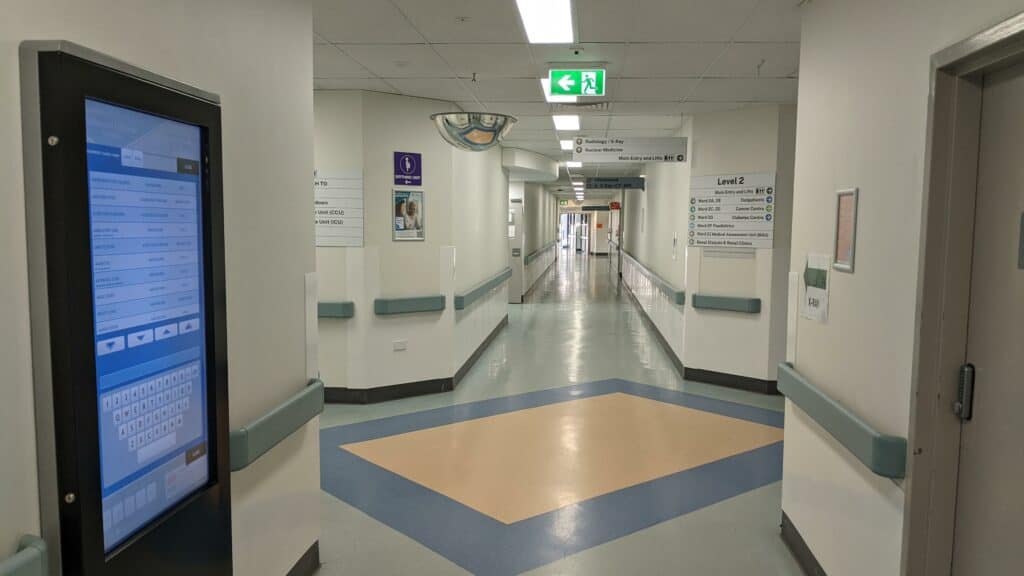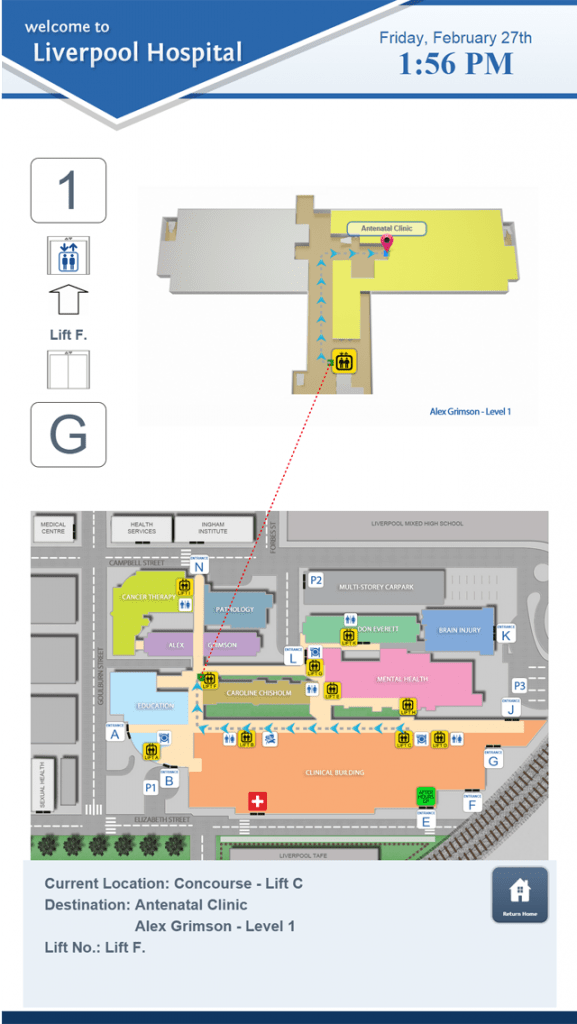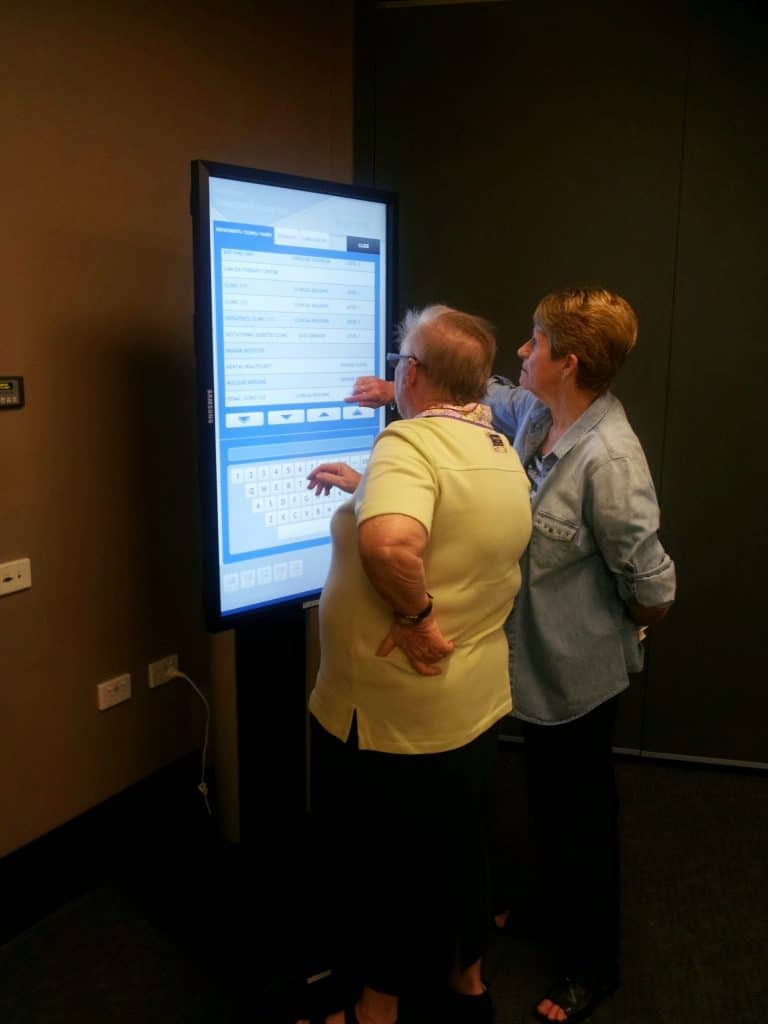In the fast-paced and often overwhelming environment of hospitals, patients and visitors can often feel lost and confused. Hospital wayfinding is a critical component of a healthcare facility design that helps patients and visitors navigate through the maze of corridors, departments, and buildings within a hospital. In Australia, a hospital can consist of multiple buildings multiple levels and this can oftentimes become very confusing for visitors and patients. Effective wayfinding systems are essential for ensuring that patients and visitors are able to quickly and efficiently find their way to the right locations within a hospital, reducing anxiety and improving their overall experience. If the hospital is going through a redevelopment project, then that is the perfect time to design and roll out a digital wayfinding solution.
Hospital wayfinding involves the use of clear digital signage, directional boards, wayfinding kiosks, maps, and visual cues to guide individuals to their desired destinations. It must also take into account the needs of different patient populations, such as those with mobility impairments or limited English proficiency. With our digital wayfinding solution, we are able to cater for all of these requirements. While wayfinding may seem like a straightforward task, it requires careful planning, design, and implementation to be successful. Over the years, we have worked with a number of hospitals to implement digital wayfinding solutions to cater for their needs and requirements.

Importance of hospital wayfinding
Hospital wayfinding is a critical aspect of the healthcare industry that cannot be overlooked. Providing a clear and intuitive wayfinding system helps patients, visitors, and staff navigate through the hospital environment, reducing stress and anxiety as well as improving operational efficiency. In fact, studies have shown that a well-planned wayfinding system can lead to increased patient satisfaction and safety. With our digital wayfinding technology, hospital wayfinding is easily accessible even with sophisticated hospital layouts and complex buildings. In addition, coupled with our QR code module, visitors and patients are able to use their mobile phones to locate their destination. These tools can additionally provide information about a patient’s location, appointment times, and provide directions to their destination. It’s important for hospitals to invest in these technologies to provide an exceptional patient experience and streamline operational workflows. By prioritising hospital wayfinding, healthcare organisations can create a more positive environment for patients, visitors, and staff alike.
Clear and concise messaging system
Having a clear and concise messaging system is an essential feature of hospital wayfinding solutions, which helps patients and visitors navigate through the complex hospital environment with ease by using digital wayfinding solutions for hospitals. Wayfinding software and wayfinding kiosks are effective tools to provide real-time directions and information to users. With a clear and concise messaging system, users can receive directions and information without confusion or frustration. The messaging system should provide information about critical areas such as emergency departments, inpatient wards, and outpatient clinics. It should also include directions to restrooms, elevators, and other important areas. In addition, the messaging system should be easy to use and accessible for all users, including those with disabilities. A well-designed messaging system can greatly improve the hospital wayfinding experience and enhance patient satisfaction.
Consistent color-coded signage
Consistent color-coded signage is a crucial element of effective hospital wayfinding. Hospitals can be complex and confusing environments, with numerous departments, units, and floors. Colour-coded signage helps visitors and patients navigate easily through the facility, reducing anxiety and frustration. Wayfinding software and wayfinding kiosks can be used to create and manage consistent colour-coded signage throughout the hospital, ensuring that visitors and patients receive clear and consistent directions. In addition, wayfinding technology can help hospitals reduce staffing costs associated with wayfinding, as visitors and patients can access information and directions independently. By implementing consistent colour-coded signage using wayfinding software and wayfinding kiosks, hospitals can improve the overall patient experience and reduce the stress and anxiety associated with navigating complex healthcare environments.
Interactive digital maps available
Interactive digital maps are an essential tool for effective hospital wayfinding. By providing real-time directions and information, these maps can help patients and visitors navigate complex hospital layouts with ease. Wayfinding software and wayfinding kiosks can be used to create interactive maps that offer a range of features, including multi-language support, facility directories, and real-time updates on wait times and appointment schedules. These maps can be accessed via hospital websites, mobile apps, and digital kiosks located throughout the facility. With interactive digital maps available, hospitals can improve the patient experience and reduce the stress and frustration associated with getting lost in a large and unfamiliar building.

Universal design for accessibility
As hospital wayfinding becomes increasingly important for patients, visitors, and staff, it’s essential to consider accessibility for all. Universal design principles ensure that wayfinding software and wayfinding kiosks are easy to use for individuals with disabilities, including those with vision, hearing, or mobility impairments. Incorporating these principles into hospital wayfinding can greatly enhance the user experience for everyone and help ensure equal access to information and navigation. Some key aspects of universal design for accessibility in hospital wayfinding include clear signage with high contrast, audio descriptions or subtitles for those with hearing or vision impairments, and wheelchair-accessible kiosks and pathways. By prioritising accessibility in wayfinding design, hospitals can create a more inclusive environment for all users.
Digital signage placement considerations
Proper placement of digital signage is an essential aspect of hospital wayfinding. It plays a significant role in helping patients, staff, and visitors navigate the hospital premises with ease. When it comes to hospital wayfinding, there are a few crucial factors to consider while determining the placement of digital signage. Firstly, digital signage should be placed in a well-lit area, at an eye-level, and in a location that is easily accessible to read. Secondly, the placement of digital signage should be strategic and intuitive, guiding individuals to their desired destination logically and efficiently. The use of wayfinding software and kiosks can enhance the efficacy of digital signage placement by providing real-time information and interactive maps to users. By considering these factors, hospitals can effectively use digital signage to improve their wayfinding system and enhance the overall patient experience. For instance, one can use digital wayfinding and signage at the hospital’s main entrance to guide patients and visitors to their respective destinations.
Implementing emergency evacuation procedures
Hospital wayfinding is a critical aspect that requires well-planned emergency evacuation procedures. In case of any emergency, it is of utmost importance to have an efficient evacuation plan in place to ensure the safety and well-being of staff, patients, and visitors. Wayfinding kiosks and software can play a vital role in emergency preparedness by providing real-time information on evacuation routes, emergency exits, and shelter areas. Hospitals must ensure that their wayfinding systems are up-to-date and easily accessible to ensure that everyone can quickly find their way to safety during an emergency. In addition, staff members should receive regular training on emergency procedures to ensure they can respond quickly and appropriately in a crisis. By prioritising emergency preparedness and utilising effective wayfinding technology, hospitals can guarantee the safety of everyone within their facilities.
Ensuring ease of navigation
Hospital wayfinding is a crucial aspect that requires ease of navigation for patients, visitors, and staff. The complex layout of hospitals can be overwhelming for many, and getting lost can lead to frustration, anxiety, and delays. To address this issue, hospitals can make use of technology such as wayfinding software and wayfinding kiosks to provide clear and concise directions to various destinations within the hospital. These tools can provide step-by-step directions, including information on distance, estimated travel time, and landmarks. Ideally, these tools should be user-friendly, intuitive, and accessible for individuals with disabilities or limited mobility. By prioritising the ease of navigation, hospitals can enhance the overall quality of care, improve the experience of patients and visitors, and reduce stress.
Training staff on the wayfinding system
Properly training hospital staff on the wayfinding system is a crucial step to ensure that patients and visitors can navigate the facility with ease. We offer our clients a complete digital wayfinding solution, including wayfinding software and kiosks, so that staff can focus on other important tasks. The wayfinding system is designed to provide clear and concise directions to different areas of the hospital, which can help alleviate confusion and frustration for patients and visitors. Staff members who are trained in the use of the wayfinding system can also be a valuable resource for patients and visitors who have questions or need additional assistance. Therefore, we recommend that all hospital staff be trained on the hospital wayfinding system to provide the best possible experience for everyone who enters the facility.

Continual evaluation and improvement
The success of hospital wayfinding is heavily reliant on continuous evaluation and improvement. Healthcare facilities and their services are constantly evolving, which makes it essential to have an adaptable and flexible wayfinding system. Wayfinding software and kiosks can provide valuable insights into user behaviour, which can be used to inform future updates and enhancements. It is crucial to regularly assess the functionality and effectiveness of the wayfinding system to ensure it remains useful and relevant to users. Hospital wayfinding teams should establish a process for gathering feedback and conducting regular audits to identify areas that need improvement. By implementing a system for continual evaluation and improvement, hospital wayfinding can enhance the patient experience and improve overall hospital operations.
We’ve done work for these hospitals:
Effective hospital wayfinding is a crucial aspect of healthcare design, which plays a critical role in enhancing the patient experience and improving overall operational efficiency. By implementing a well-planned and strategic wayfinding system, healthcare facilities can reduce patient stress, improve patient outcomes, and enhance the overall quality of care. To create a comprehensive system that meets the unique needs of patients and staff, healthcare facilities need to collaborate with experts in wayfinding design. Ultimately, an efficient wayfinding system can help healthcare facilities create a more supportive and streamlined environment for everyone involved.

